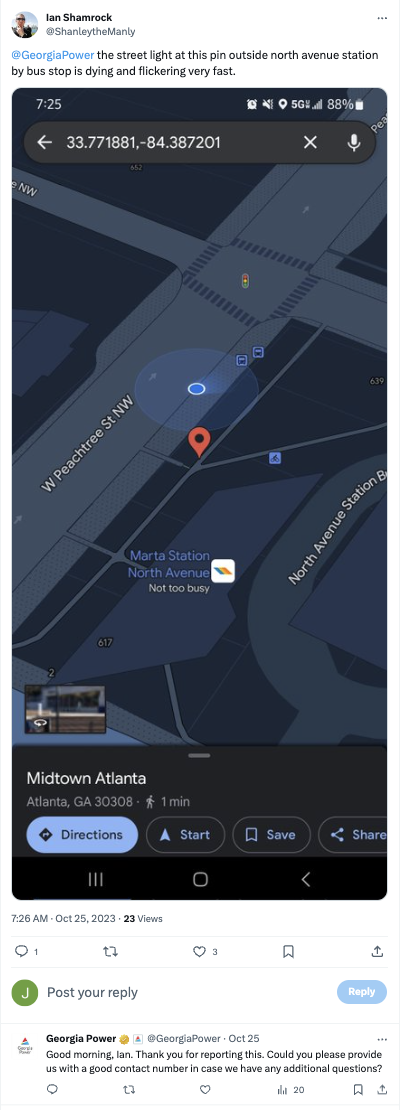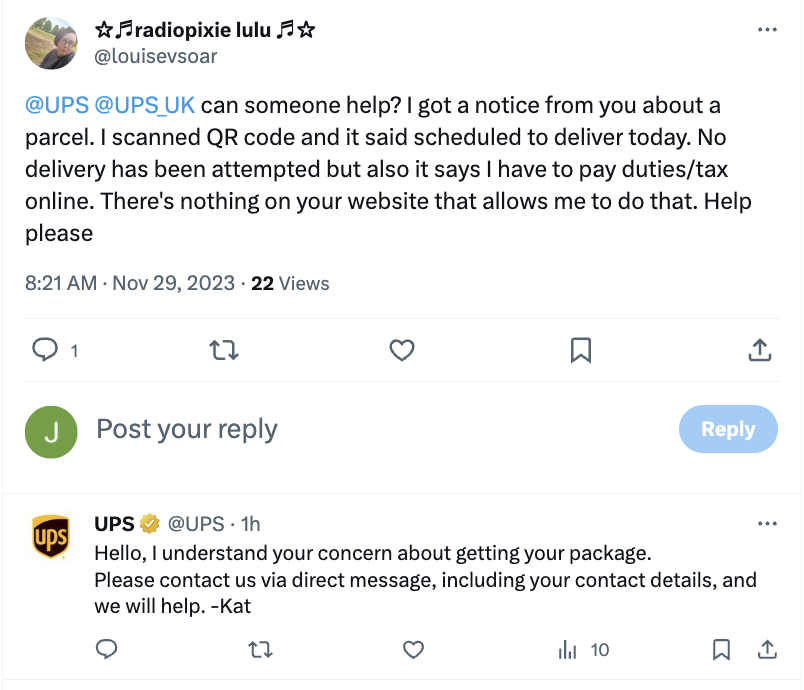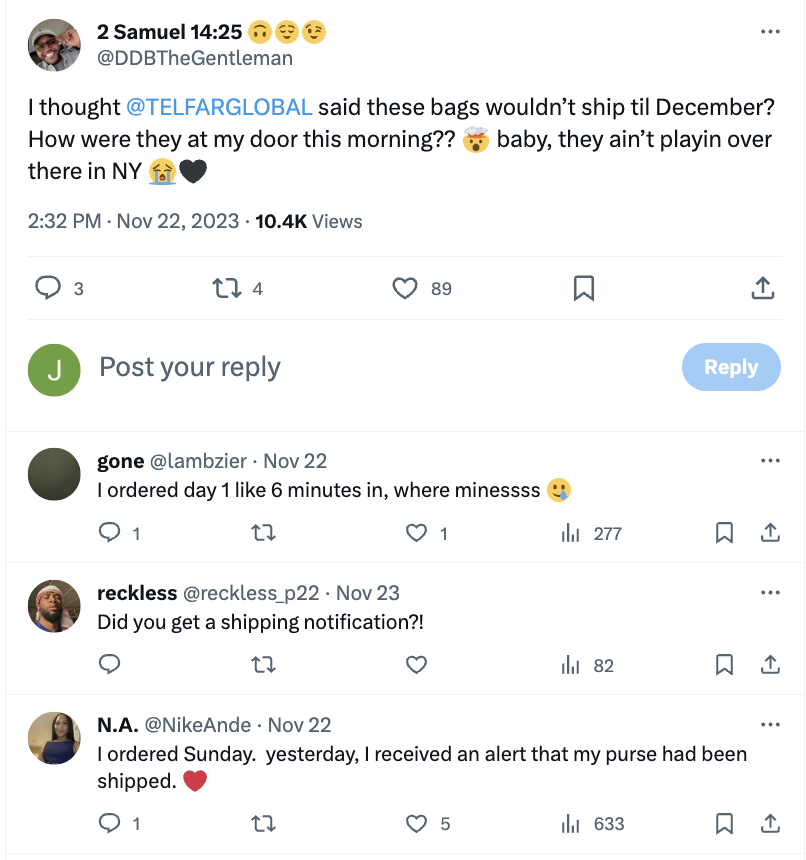What does it mean to have exceptional customer service? Automated phone systems? Chatbots? Help guides? These ease your customer support teams’ workload, but they don’t always cater to the needs of your customers—especially if they have a unique or urgent issue.
When they’re facing a problem, customers don’t want to click through a series of irrelevant options or dig through a list of FAQs, only to find none of them address their personalized needs. Tools like chatbots and help centers are helpful for basic knowledge, tips and reminders, but we still need humans to escalate complex support or questions. Today’s consumers want access to a human as soon as possible—and they often go to social media customer service to achieve this.
In The Sprout Social Index™, we found over half (53%) of consumers say their social media usage has been higher over the last two years than the previous two years. Our data also found 76% of consumers notice and appreciate when businesses prioritize customer support.
So brands—now’s the time to build a social customer care strategy (if you don’t already have one). Not sure where to start?
In this piece, we’ll explore what customers are looking for from brands and share leading social media customer care statistics so teams can build stronger relationships in 2024 onward.
Explore other latest social media stats that reflect the changing consumer behavior on social networks.
How do customers use social media for support?
Brands have several options for delivering customer support, but social media is a crowd favorite. But how are customers using social channels to receive support from brands?
“About 70% of my customers reached out to me through social media channels, the other 30% by email,” said Zoila Streich, Co-Founder of Independent Fashion Bloggers and former fashion business owner. “Most questions are about product availability and payment methods, but a few are feedback about the products or the buying process.”
You’ll also find customers using social to report service outages:

Or to point out issues with shipments and deliveries:

It’s disheartening to get negative feedback, but being respectful and helpful to each customer’s request will help in the long run. Our Index data shows over half of consumers say the most memorable brands on social media respond to customers.
Combining a great product with quality service and excellent support sets you up for more positive remarks from customers. For example, a Telfar customer raved about the brand’s fast shipping.

Another customer thanked the brand for rectifying an issue through quality customer service:

How do customer care professionals use social media for support?
In our Q3 Pulse Survey, we surveyed 336 customer care professionals. Our data shows managing a high volume of requests is the top challenge for organizations, so scaling your social customer service strategy is a must.
While it’s great to have this two-way communication with customers, a customer service-filled feed can distract from other campaigns and promotions your brand is trying to highlight. This is why some brands have dedicated social media accounts solely for customer care.
“Businesses use social media for a variety of purposes, including marketing, engaging with customers, interacting with influencers and more,” said Keenan Beavis, founder of Longhouse Media. “That’s why having a distinct social media account dedicated to customer support inquiries is so important. You don’t want your advertising, likes and shares to bury client demands and questions.”
Make sure to prepare for the ebbs and flows of incoming customer support requests. New product launches or promotions lead to an influx of sales, which means more opportunities for inbound questions.
The volume of customers using our social media customer support fluctuates between 40% to 60%, depending on promotions,” said Yuvi Alpert, Founder, Creative Director and CEO of jewelry brand Noémie. “Because we drive people to our social media profiles through other channels, such as our newsletter, many of the questions we receive come through those platforms.”
Our data shows there are several strategies marketers plan to implement to scale social customer care. The top three include self-service tools/resources like chatbots and forums, social media management tools, and artificial intelligence (AI) and automation.

How quickly do brands need to reply to customer service messages on social?
Being present on social media is great. But having a fast response rate sets apart the “best in class” brands from the “I’m unfollowing you because your customer service is horrible” brands.
How fast is fast enough? In many cases, it depends on the industry and the situation.
For instance, Yuvi Alpert previously told us one day is fast enough during promotions. “It is critical that we answer those questions within 24 hours. We found that allowing more time to elapse lowers customer interest. By offering prompt responses, we see dramatic increases in sales of featured items.”
As customers continue to flock to social for their support needs, it takes more effort to maintain speedy response times.
But what is the response time sweet spot according to customers? Our Index data shows 76% of consumers value how quickly a brand can respond to their needs. Nearly 70% expect a response within 24 hours or less.

At one time, taking a day or more to respond to a customer was acceptable. But now most consumers demand instant access and gratification. That’s why leading brands in social media customer service, like MeUndies, set goals for faster response times. When the underwear brand set a goal of replying to all messages within a 60-minute window, they needed an alternative to responding natively through social platforms.
They turned to Sprout’s Smart Inbox to get an all-encompassing view of their Instagram direct messages, mentions and comments in one stream.

Now, be mindful that a fast response isn’t the primary goal—it’s to resolve customers’ issues. Unfortunately, some brands are quick to reply but slow to resolve. When that happens, unhappy customers will let you (and all their followers) know. Customers want more than timeliness when it comes to quality customer care–they want a solution.
How important is social media customer service to consumers?
Along with timely responses, our Index data reveals 70% of consumers expect a company to provide personalized responses to customer service needs. Our data also found 63% of consumers agree their loyalty to a brand is significantly influenced by the quality of customer service they provide on social media.
With social media customer service statistics like these, there’s only one thing to do: Improve your social media A-game, so you don’t fall into the trenches of negative reviews.
Being consistent with your customer support builds trust and loyalty. Catering to the personalization consumers want can also inspire them to go out of their way to show praises in public (hello, social proof).
For example, as a part of their Telfar Gifted promotion, Telfar shared with participants personalized AI-generated videos featuring designer Telfar Clemens and customers raved about it:


Social media has transformed the balance of power between brands and consumers. Only on social can people compare a brand’s support practices to its competitors in less than a few clicks. The public nature of social has influenced many brands to rethink customer care quality and the roster of standard support channels.
But manually responding to every message—especially when you have multiple social media accounts and thousands of customers—is not sustainable.
With a tool like Sprout Social, customer care teams can organize and filter incoming messages across platforms, triage responses to Cases and view critical customer information all in one place.

Start your free Sprout trial
Social media customer service statistics by network
Now that we’ve covered consumer behavior and their preferences, let’s cover some insightful social media customer service statistics by network.
Instagram customer service statistics
Instagram is one of the most popular social media channels for customer service. Our 2022 Sprout Social Index found that 35% of U.S. consumers use Instagram for customer service. This makes it the second most popular platform for customer service after Facebook. Instagram also has over one billion active users so it’s very likely your audience is on the platform, which means you’ll need to incorporate it into your social media customer care strategy.

Facebook customer service statistics
Around 74% of online adults say they feel more connected with a business when they can message the business directly on Messenger, Facebook’s direct messaging platform. Meta also found that another 66% of consumers agree that messaging is their preferred way of communicating to a business.
The takeaway? If your customers are on Facebook, then you should be too.
OLIPOP, a tonic brand, uses Facebook to offer direct customer support. “I’d estimate at least 50% of our customers will message us questions or comment directly on our posts across Facebook and Instagram,” Melanie Bedwell, eCommerce Manager for OLIPOP previously told us. “Ideally, we try to reply instantly, but if that’s not possible, then at least during the same day.”
Here are examples of their engagement with happy customers:


They also use opportunities to promote their in-store options (and their tool to locate one near you).
Threads customer service statistics
Time will reveal what customer care looks like on Threads as an emerging platform, but our Q4 2023 Pulse survey illustrates some interesting stats for brands to consider:
- 73% of consumers say they haven’t created a Threads account yet, compared to 27% of consumers who have created an account. Of the 27% of consumers who created a Threads account, roughly one-third use it weekly while another third use it daily.
- The majority (75%) of consumers said they plan to use Threads daily or weekly.
- While younger generations are more likely to have a Threads account than older generations, usage differs slightly for Millennials and Gen Z. Twice as many Millennials as Gen Z consumers say they use Threads daily. However, twice as many Gen Z consumers compared to Millennials say they have an account but don’t use it.
In other words, the platform is still growing, but this means there’s an opportunity to appeal to the customers who use Threads.
TikTok customer service statistics
Has TikTok ever made you buy something? Welcome to the club.
Our Q4 survey shows TikTok, Facebook and Instagram are the top three platforms consumers expect to use to contact brands during the holiday customer service season. The survey also shows that 56% of Gen Z and 42% of Millennials use newer platforms like TikTok to communicate with brands.
You can incorporate customer care on the platform in the TikTok comments section. Use video comments to respond to questions or implement an escalation protocol to address customer concerns on the platform.
X (formerly known as Twitter) customer service statistics
X is a popular channel people use to compliment or complain about a brand. Here’s a quick list of stats you should know:
- About 64% of X users even say they’d rather send a message to a dedicated support handle than call a business.
- Over half (53%) of users find it helpful to see how brands answer questions or solve issues publicly.
- The most popular reasons for seeking out customer service on this platform include product defectiveness (37%), order issues (29%) and bad in-person experiences (29%), according to our data report, How to Use Twitter to Take Better Care of Your Customers.
Improve customer experiences with social media customer service
Your business profiles on social channels aren’t just about promoting products and services—they’re an essential place where today’s consumers seek out and expect quality customer support.
Ready to build relationships with your customers? Check out our interactive customer service data story to get started.